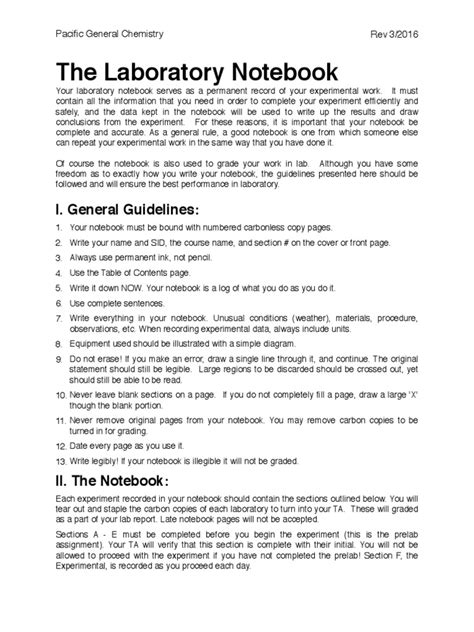Sample Lab Notebook

A lab notebook is an essential tool for scientists, researchers, and students, serving as a detailed record of experiments, observations, and data. It provides an organized way to document the journey of scientific exploration, ensuring reproducibility and allowing for effective collaboration. In this article, we delve into the world of lab notebooks, exploring their significance, best practices, and the impact they have on scientific research and innovation.
The Importance of a Well-Maintained Lab Notebook

A lab notebook serves as the primary source of truth for any experimental work. It provides a chronological account of the entire research process, from initial ideas and hypotheses to the final outcomes and conclusions. Here’s why maintaining a comprehensive lab notebook is crucial:
- Reproducibility: Lab notebooks ensure that experiments can be reproduced accurately. By documenting every step, including methods, materials, and conditions, researchers can recreate successful experiments or troubleshoot issues that arise.
- Collaboration and Communication: Shared lab notebooks facilitate effective collaboration among team members. They provide a common platform for discussing ideas, interpreting results, and planning future experiments. Well-documented notebooks also aid in communicating research findings to peers and the scientific community.
- Data Integrity and Analysis: Lab notebooks serve as a central repository for raw data, allowing researchers to analyze and interpret results with precision. They help track data trends, identify anomalies, and draw meaningful conclusions from experimental data.
- Legal and Intellectual Property Protection: In the event of a patent dispute or legal matter, a detailed lab notebook can be crucial evidence. It provides a clear timeline of discoveries, inventions, and innovations, safeguarding intellectual property rights.
- Learning and Personal Growth: For students and early-career researchers, lab notebooks are valuable learning tools. They offer a chance to reflect on past experiments, identify areas for improvement, and develop critical thinking and analytical skills.
Best Practices for Lab Notebook Maintenance

To ensure the effectiveness and integrity of a lab notebook, certain best practices should be followed. Here are some key guidelines:
1. Consistency and Organization
Maintain a consistent format throughout your lab notebook. Use clear headings, dates, and page numbers to easily locate specific entries. Organize your notebook by experiment or project, ensuring each section is well-structured and easily navigable.
2. Detail-Oriented Documentation
Record every aspect of your experiment in detail. This includes the purpose, hypothesis, methods, materials used, and step-by-step procedures. Note any modifications or deviations from the original plan and their reasons. Document observations, measurements, and raw data accurately, using appropriate units and precision.
| Experiment Date | Purpose | Materials |
|---|---|---|
| 03/12/2023 | Investigate the effect of temperature on enzyme activity. |
|
| 03/14/2023 | Repeat experiment with additional controls. |
|

3. Clear and Legible Handwriting or Typing
Ensure that your handwriting is legible or, if using a digital notebook, maintain a clear and consistent font. This is crucial for future reference and collaboration. If making corrections, use a single-line strike-through to indicate changes while keeping the original text visible.
4. Regular Backups and Digital Storage
In today’s digital age, it’s essential to back up your lab notebook regularly. Consider using digital lab notebook software or cloud storage to ensure data security and easy accessibility. This also allows for efficient data sharing and collaboration with colleagues.
5. Include Visuals and Annotations
Visual aids, such as diagrams, graphs, and photographs, can greatly enhance your lab notebook. Use clear labels and annotations to explain the significance of each visual element. This not only improves understanding but also aids in data analysis and presentation.
The Impact of Lab Notebooks on Scientific Progress
Lab notebooks play a pivotal role in advancing scientific knowledge and innovation. They contribute to the scientific community in several ways:
- Replication and Validation: Well-documented lab notebooks enable other researchers to replicate experiments, validate findings, and build upon existing knowledge. This is essential for the progress of science and the development of new technologies.
- Data Analysis and Interpretation: By providing a comprehensive record of experimental data, lab notebooks facilitate advanced data analysis techniques. Researchers can identify patterns, correlations, and trends, leading to new insights and discoveries.
- Education and Training: Lab notebooks serve as valuable teaching tools. They provide a practical understanding of the scientific method, experimental design, and data interpretation. Students can learn from real-world examples and develop critical thinking skills.
- Patent and Intellectual Property Protection: As mentioned earlier, lab notebooks are crucial for protecting intellectual property rights. They provide a clear timeline of innovations, inventions, and discoveries, ensuring legal protection and recognition for the researchers involved.
Conclusion
A lab notebook is more than just a record of experiments; it is a tool that empowers scientists and researchers to explore, innovate, and contribute to the advancement of knowledge. By maintaining a well-organized and detailed lab notebook, researchers can ensure the reproducibility of their work, facilitate collaboration, and leave a lasting impact on the scientific community.
How often should I update my lab notebook entries?
+It is recommended to update your lab notebook entries immediately after each experiment or significant observation. This ensures that you capture all the details while they are fresh in your mind. Regular updates also help maintain consistency and organization in your notebook.
Can I use a digital lab notebook instead of a physical one?
+Yes, digital lab notebooks are becoming increasingly popular due to their convenience and accessibility. They offer features like real-time collaboration, data storage, and backup. However, ensure that you choose a secure and reliable platform to maintain data integrity.
What should I do if I make a mistake in my lab notebook?
+If you make a mistake, it’s important to acknowledge it. Use a single-line strike-through to indicate the error while keeping the original text visible. Add a brief note explaining the mistake and any corrective actions taken. This maintains the integrity of your notebook and provides valuable learning opportunities.
How can I ensure the security of my digital lab notebook data?
+To ensure data security, choose a reputable digital lab notebook platform that offers encryption and secure storage. Regularly back up your data to multiple locations, including cloud storage and external hard drives. Additionally, consider implementing access control measures to restrict unauthorized access.



